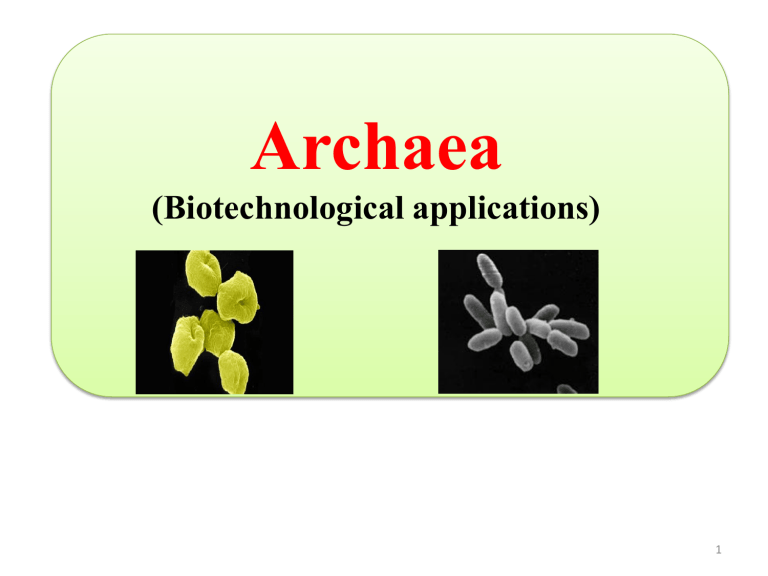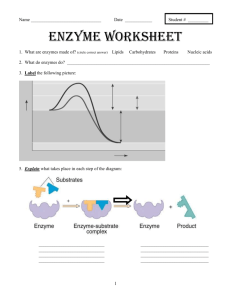
Archaea (Biotechnological applications) 1 Biotechnological Applications: • The extremophilic nature of many Archaea: to probe the potential biotechnological applications of their stable cellular components. • This is particularly true of their enzymes (called extremozymes), which are able to remain catalytically active under extremes of temperature, salinity, pH and pressure. • Many interesting enzymes have been isolated from extremophilic microbes. • Specific archaeal metabolites have also been purified and characterized and some of them have potential industrial uses. • Genes encoding several enzymes from extremophiles have been cloned in mesophilic hosts, with the objective of overproducing the enzyme and altering its properties to suit commercial applications. • Escherichia coli, Bacillus subtilis and yeasts have been used successfully as mesophilic hosts for several archaeal genes. Genetic engineering techniques are valuable tools for creating novel biocatalysts that can improve bioprocesses and facilitate the realization of innovative or novel biotransformations. • Molecular biology has the potential both to overcome the limitations on enzyme availability and to design new biocatalysts specific to a particular industrial purposes. 2 Table 1. Industrial applications of archaeal products. Phenotype Condition Thermophile High temp. (45 - 110ºC) Amylase Psychrophile Low temp. (>15ºC) Product Application Glucose, fructose for sweeteners Xylanases Paper bleaching proteases Baking, brewing, detergents DNA polymerase Genetic engineering Proteases Cheese maturation, dairy production Dehydrogenases Biosensors Amylases Polymer degradation in detergents Acidophile Low pH (0-4) Sulfor oxidation Desulfurization of coal Alkalophile High pH (8-11) Cellulase Polymer degradation in detergents Halophile High salt concentration Whole M.O. Biopolymer Piezophile High pressure Whole M.O. Formation of gels and starch granules Methalophile High metal concentration Whole M.O. Bioremediation, biomineralization Radiophile Whole M.O. Bioremediation of radionuclide contaminated sites High radiation level 3 Gluco hydrolyzing enzymes: • Complex structure of starch so, a number of enzymes are needed for its degradation. • Endo-acting enzymes, such as α-amylase, hydrolyse linkages in the interior of the starch polymer in a random fashion, which leads to the formation of linear and branched oligosaccharides. • Exo-acting enzymes (α and β-glucoamylases) attack the substrate from the nonreducing end, producing oligo and/or monosaccharides. • The finding of new extremely thermostable starch-hydrolysing enzymes, such as amylases and pullulanases, will significantly improve the industrial starch bioconversion process. • Investigations concerning recombinant α-amylases from Pyrococcus woesei indicate their suitability for starch processing. • The study of recombinant β-galactosidase from P. woesei suitable for purpose of low lactose milk and whey production is also presented. • The activity of this enzyme in a wide pH range of 4.3-6.6 and high thermostability suggests that it can be used for processing of dairy products at temperatures which restrict microbial growth during a long operating time of continuous-flow reactor with an immobilized enzyme system. 4 • Preparation of recombinant α-amylase and β-galactosidase was facilitated by cloning and expression of genes from P. woesei in E. coli host. Satisfactory level of recombinant enzymes purification was achieved by thermal denaturation and precipitation of native proteins originated from E. coli. The obtained α-amylase has maximal activity at pH 5.6 and 93ºC. The half-life of this preparation (pH 5.6) at 90ºC and 110ºC was 11 h and 3.5 h, respectively. • A hyperthermostable glycosidase enzyme with pullulanase activity at 90ºC from Thermococcus aggregans was cloned and expressed in E. coli. Unlike all other pullulan-hydrolyzing enzymes described, the enzyme is able to attack α-1,6- as well as α-1,4-glycosidic linkages, affording a mixture of maltotriose, maltose and glucose. The enzyme is also able to degrade starch, amylose and amylopectin, forming maltotriose and maltose as main products. • Halophilic glycosidases have also been identified, including a halophilic βgalactosidase from Haloferax alicantei. The extremely halophilic galactosidase from Haloferax alicantei is optimally active at 4 M NaCl. Purification of the enzyme was facilitated by the ability of sorbitol to stabilize enzyme activity in the absence of salt, which allowed conventional ion-exchange chromatography. 5 • The continuous production of halophilic α-amylase can be performed via wholecell immobilization of Halobacterium salinarum in alginate beads and a polyvinyl alcohol film. The cells were osmotically stable and showed continuous enzyme production for 45 days. The stabilized cells could be permeabilized by chloroform treatment without leakage of the intracellular components. Using this procedure, cells can be reused under improved stabilized conditions for biotechnological applications DNA processing enzymes: • One of the most important advances in molecular biology was the development of the polymerase chain reaction (PCR). Thermostable DNA polymerases play a major role in PCR and in a variety of molecular biological applications, e.g. DNA amplification, cloning, sequencing or labeling. Several native and recombinant polymerases have been purified and characterized. • DNA polymerase I from the bacterium Thermus aquaticus, called Taq polymerase, was the first thermostable DNA polymerases utilized in PCR. Archaeal proof-reading polymerases, such as Pwo from Pyrococcus woesei, Pfu from P. furiosus, Deep Vent polymerase from the Pyrococcus strain GB-D and Vent polymerase from Thermococcus litoralis, have an error rate that is up to tenfold lower than that of Taq polymerase. 6 Esterases and lipases: • In the field of biotechnology, esterases are receiving increasing attention because of their application in organic biosynthesis. • In aqueous solution, esterases catalyze the hydrolytic cleavage of esters to form the constituent acid and alcohol whereas, in organic solutions, the transesterification reaction is promoted. • Both the reactants and the products of transesterification are usually highly soluble in the organic phase and the reactants may even form the organic phase themselves. • The P. furiosus esterase and lipase genes have been cloned in E. coli and the functional properties have been determined. • The archaeal enzyme is the most thermostable (a half-life of 50 min at 126ºC) and thermoactive (optimum temperature of 100ºC) esterase known to date. 7 Archaeosomes: Liposomes are lipid-bilayer bounded vesicles that can be used as a delivery vehicle for certain vaccines, enzymes and drugs. The term “Archaeosome” was introduced by Sprott and co-workers to describe liposomes made with ether lipids that are unique to the Archaea domain confering considerable stability on liposomal vesicles. Extensive mouse model studies involving intravenous, oral and subcutaneous administration of archaeosomes demonstrated that archaeosomes are safety molecules and they are not toxic. 8 Proteases and Peptidases: • The amount of proteolytic enzymes produced world-wide on a commercial scale is larger than that of any of the other biotechnologically used enzymes. • Serine alkaline proteases are used as additives to household detergents for laundering where they must resist denaturation by detergents and alkaline conditions. • The leather industry uses proteinases with high keratinolytic and elastolytic activities for soaking. The discovery of proteases that can catalyze reactions under extreme conditions (high temperatures and extremes of pH) will be valuable for industrial applications. • An extracellular serine protease from the extreme halophile Halobacterium halobium may be an excellent catalyst for peptide synthesis, exploiting their reverse reaction, particularly for glycine-containing peptides. The enzyme requires 4 M NaCl for optimal catalytic activity and stability in aqueous solutions. The stabilization of halophilic enzymes by organic solvents while lowering the required salt concentration is of practical importance because high NaCl concentrations can be corrosive to metals. Higher substrate solubility in the presence of an organic solvent can be useful in synthetic reactions catalyzed by enzymes from extreme halophiles. 9 • Many biotechnologically interesting serine proteases have been identified and characterized. • Among them is a cell associated serine protease, characterized from Desulfurococcus strain SY, which showed a half-life of 4.3 h at 95ºC. A globular serine protease from Staphylothermus marinus was found to be extremely thermostable. This enzyme has residual activity even after 10 min of incubation at 135ºC. • Another gene encoding a subtilisin-like serine protease, named aereolysin, has been cloned from Pyrobaculum aerophilum and the protein was modelled on the basis of structures of subtilisin-type proteases. • Multiple proteolytic activities have been observed in Pyrococcus furiosus. The cell envelope associated serine protease of P. furiosus, called pyrolysin, was found to be highly stable with a half-life of 20 min at 105ºC. The pyrolysin gene was cloned and sequenced and it was shown that this enzyme is a subtilisin-like serine protease. • Proteases have also been characterized from the thermoacidophilic archaeon, Sulfolobus solfataricus and Sulfolobus acidocaldarius. 10 • In addition to the serine proteases, other types of enzymes have been identified in extremophiles. Good examples are a thiol protease (propylpeptidase) from Pyrococcus sp. and a new type of protease from P. furiosus. • Psychrophilic enzymes have potential applications in a broad range of industrial, agricultural and medical processes. The recent interest in this field is due to the challenge of finding stable proteases that function in cold water. • In addition, peptidyl synthesis studies with mesophilic enzymes have shown that low temperature favors high yields because of reduced hydrolysis of the acyl-enzyme intermediate. • In most other processes, reduced energy consumption due to low temperature operation will be a significant advantage. 11




